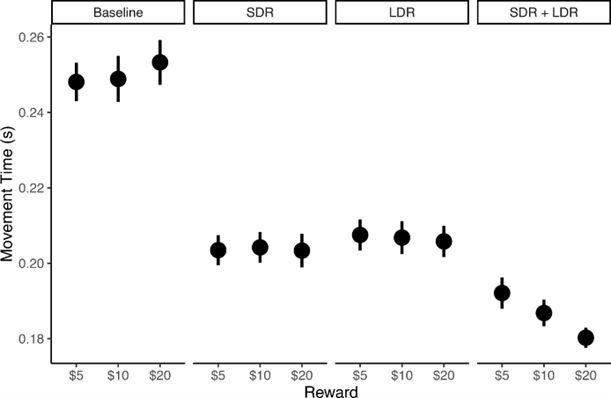Objective: To assess the relationship between the Short Duration Response (SDR) and Long Duration Response (LDR) to L-Dopa therapy in Parkinson disease (PD) and restoration of coupling between motivation and movement vigor.
Background: Bradykinesia is suggested to be impaired movement vigor secondary to deficient modulation of outcome-effort coupling (motivation) following striatal dopaminergic denervation. Prior experiments in PD subjects utilized chronically treated subjects, obscuring the potential roles of the SDR and LDR in restoration of a vigor-motivation link. To disambiguate the roles of the SDR and LDR, we studied de novo PD subjects with a standard motivation task before and after chronic L-Dopa treatment.
Method: Twelve de novo PD subjects (7M:5F; mean age 67) were studied prior to treatment, after an acute L-Dopa dose, and in both the practical “Off” and “On” states after chronic stable treatment. At each visit, subjects were characterized with the MDS-UPDRS, PD-CRS, GDS, Lille Apathy Scale, and an incentivized joystick task to assess motor performance in response to varying prospective rewards.
Results: Mean subject baseline total UPDRS 43.6; PD-CRS 98.6; GDS 3.9; Lille 10.8. L-Dopa induced a significant SDR (mean total UPDRS 34.4) and a robust LDR ([practical “Off”; mean total UPDRS 25.9), with further improvement in the SDR+LDR state (practical “On”; mean total UPDRS 20.6). At baseline evaluation, after acute treatment (SDR), and after LDR induction (practical “Off”), subjects did not exhibit the normal increase in movement vigor with increasing reward ($5 vs. $20; movement speed SEM; Baseline: 242 +- 5 ms vs. 247 +- 6 ms; SDR: 202 +- 4 ms vs. 203 4 ms; LDR: 206 +- 4 ms vs. 204 +- 4 ms). Only in the combined SDR+LDR state (practical “On” state) was there relative normalization of movement vigor–reward coupling ($5 vs. $20; 192 +- 4 ms vs. 181 +- 2 ms).
Conclusion: Restoration of movement vigor-motivational coupling was found only in the combined SDR+LDR state. While consistent with prior results in chronically treated PD subjects, the significant improvement in bradykinesia seen with both the SDR (acute treatment) and particularly the LDR (chronic treatment – practical “Off” state) suggests that bradykinesia is not solely secondary to deficient modulation of motivational processes.
To cite this abstract in AMA style:
J. Brissenden, T. Scerbak, R. Albin, T. Lee. The Short Duration Response and Long Duration Response to L-Dopa are Needed to Restore Vigor-Motivation Coupling in Parkinson Disease [abstract]. Mov Disord. 2023; 38 (suppl 1). https://www.mdsabstracts.org/abstract/the-short-duration-response-and-long-duration-response-to-l-dopa-are-needed-to-restore-vigor-motivation-coupling-in-parkinson-disease/. Accessed December 27, 2025.« Back to 2023 International Congress
MDS Abstracts - https://www.mdsabstracts.org/abstract/the-short-duration-response-and-long-duration-response-to-l-dopa-are-needed-to-restore-vigor-motivation-coupling-in-parkinson-disease/

